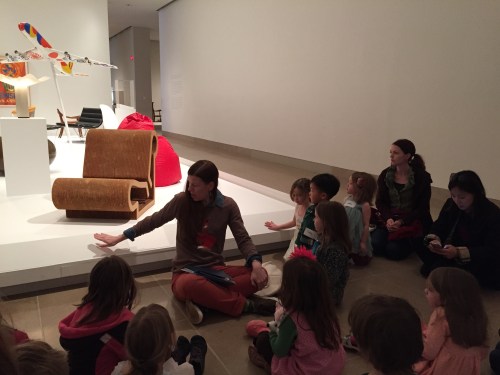
In our family classes here at the Museum, we try to make sense of the art in more ways than one! Whether it’s through tactile objects that mimic textures we see in a painting, or listening to music that inspired certain works of art, we do our best to find creative ways to engage more than just our sense of sight when exploring the galleries. For this month’s Art Babies class, we kicked it up a notch and focused on our sense of smell.
Since babies already naturally rely on the five senses—sight, smell, taste, touch, and hearing—to learn about the world around them, they were the perfect audience for this sort of experiment. For me, though, it was a fun challenge to imagine smell as a pathway for exploring art. How could I bring smells into the galleries that were both baby-safe and art-safe? And how could I be playful and engaging in my approach? My solution—puppets and spice jars!

We began with a story featuring Jack the dog, inspired by Claude-Joseph Vernet’s painting A Mountain Landscape with an Approaching Storm. Jack smells something new in the air and sniffs from one furry friend to the next trying to discover what the smell could be. I used a loveable puppet to bring the story to life, and Jack quickly became fast friends with our little visitors. Several wanted to hug and kiss him, but they also imitated the puppet’s sniffing, and as the story progressed, more and more babies would scrunch up their noses and make sniffing noises along with Jack. (The little one pictured above was one of my most expressive sniffers!) When Jack finally discovers that his mystery smell is the scent of rain, the children and their caregivers made their own discovery too—finding a little dog in Vernet’s painting and noticing the ominous clouds in the top corner of the landscape.
Now that we had planted the idea of using smell to better understand what we see, families set off on a smelling adventure through the galleries, using repurposed spice jars filled with a variety of scents—from apple blossom and rain to fresh hay and mountain air!

Babies sniffed, shook the bottles like rattles, and stuck them in their mouths. Adults searched for paintings with objects that matched the smells. Together grown-ups and children found new ways to experience art.

Before the shrieks of delight and giggles could dissolve into tears or frustration at not being able to touch, we left the galleries and made our way to our sensory play stations. Here, any and everything can be picked up, mouthed, dropped, smelled, rolled, bounced, and more. And for a special smell-inspired play area, we offered the babies fresh flowers, oranges, lemons, and limes to smell and investigate.
I do believe that these little ones have quite a nose for art!
You can create your own smell-based sensory play at home with recycled spice jars, cotton balls, and scents. I found inspiration from this blog post. Be sure to avoid scents that might create a burning sensation (like wasabi, chili powder, mustard or pepper). My go-to source for unusual scents is the Demeter Fragrance Company. Smells like art to me!
Leah Hanson
Manager of Early Learning Programs

























































